1. Spitzberg BH, Cupach WR. Handbook of Interpersonal Competence Research. 1st ed. New York: Springer-Verlag;1989. p. 1–235.
2. Sullivan HS. Sullivan Conceptions of Modern Psychiatry (Cloth). 2nd ed. New York: WW Norton & Co;1953. p. 30–56.
3. Spitzberg BH, Canary DJ. Loneliness and relationally competent communication. J Soc Pers Relatsh. 1985; 2(4):387–402.

4. Park K. The effect of negative life stress and interpersonal problem on woman’s depression. Kor J Psychol (Health). 2003; 8(3):581–93.
5. Bae MJ, JO HI. The relationship between covert narcissism, self-esteem, cognitive/affective empathy and interpersonal competence. Korea Journal of Counseling. 2014; 15(6):2417–35.
6. Erikson EH. Identity, youth and crisis. 1st ed. New York: W. W. Norton Company;1968. p. 91–141.
7. Ju SJ. The effects of human relationships class on university students’ interpersonal problem level and interpersonal competence. Korean Journal of Youth Studies. 2012; 19(7):79–99.
8. Ju HJ. An analysis on job adjustment barriers of new college graduates. The Korean Journal of Human Resource Development Quarterly. 2012; 14(1):73–93.
9. Brown PM, Foster SB. Integrating hearing and deaf students on a college campus: successes and barriers as perceived by hearing students. Am Ann Deaf. 1991; 136(1):21–7.

10. Murphy JS, Newlon BJ. Loneliness and the mainstreamed hearing impaired college student. Am Ann Deaf. 1987; 132(1):21–5.

11. Kersting SA. Balancing between deaf and hearing worlds: reflections of mainstreamed college students on relationships and social interaction. J Deaf Stud Deaf Educ. 1997; 2(4):252–63.

12. Song JY. Qualitative study on difficulties and needs to support of students with hearing impairment in integration: In cases of N University [dissertation]. Cheonan: Korea Nazarene Univ;2008.
13. Foster S, DeCaro PM. Mainstreaming hearing-impaired students within a postsecondary educational setting: an ecological model of social interaction. Boston: National Technical Inst. for the Deaf;1990. p. 1–33.
14. Blamey PJ, Sarant JZ, Paatsch LE, Barry JG, Bow CP, Wales RJ, et al. Relationships among speech perception, production, language, hearing loss, and age in children with impaired hearing. J Speech Lang Hear Res. 2001; 44(2):264–85.

15. Colletti L. Long-term follow-up of infants (4-11 months) fitted with cochlear implants. Acta Otolaryngol. 2009; 129(4):361–6.

16. Geers AE, Hayes H. Reading, writing, and phonological processing skills of adolescents with 10 or more years of cochlear implant experience. Ear Hear. 2011; 32(1 Suppl):49S–59S.

17. Nikolopoulos TP, Archbold SM, O’Donoghue GM. The development of auditory perception in children following cochlear implantation. Int J Pediatr Otorhinolaryngol. 1999; 49 Suppl 1:S189–91.

18. Buhrmester D, Furman W, Wittenberg MT, Reis HT. Five domains of interpersonal competence in peer relationships. J Pers Soc Psychol. 1988; 55(6):991–1008.

19. Han NR, Lee DG. Validation of he Korean version of the interpersonal competence questionnaire in Korean college students. The Korean Journal of Counseling and Psychotherapy. 2010; 22(1):137–56.
20. Jang HS. The effects of conf lict management strategies and communication competence on relational outcomes. Korean Journal of Communication & Information. 2003; (23):113–51.
21. Premack D, Woodruff G. Does the chimpanzee have a theory of mind? Behav Brain Sci. 1978; 1(4):515–26.

22. Peterson CC, Siegal M. Deafness, conversation and theory of mind. J Child Psychol Psychiatry. 1995; 36(3):459–74.

23. Peterson CC. Theory-of-mind development in oral deaf children with cochlear implants or conventional hearing aids. J Child Psychol Psychiatry. 2004; 45(6):1096–106.

24. Remmel E, Peters K. Theory of mind and language in children with cochlear implants. J Deaf Stud Deaf Educ. 2009; 14(2):218–36.

25. Sundqvist A, Lyxell B, Jönsson R, Heimann M. Understanding minds: early cochlear implantation and the development of theory of mind in children with profound hearing impairment. Int J Pediatr Otorhinolaryngol. 2014; 78(3):537–43.

26. Ziv M, Most T, Cohen S. Understanding of emotions and false beliefs among hearing children versus deaf children. J Deaf Stud Deaf Educ. 2013; 18(2):161–74.

27. Ketelaar L, Rieffe C, Wiefferink CH, Frijns JH. Does hearing lead to understanding? Theory of mind in toddlers and preschoolers with cochlear implants. J Pediatr Psychol. 2012; 37(9):1041–50.

28. Hao J, Su Y, Chan RC. Do deaf adults with limited language have advanced theory of mind? Res Dev Disabil. 2010; 31(6):1491–501.

29. Punch R, Hyde M. Social participation of children and adolescents with cochlear implants: a qualitative analysis of parent, teacher, and child interviews. J Deaf Stud Deaf Educ. 2011; 16(4):474–93.

30. Punch R, Hyde MB. Communication, psychosocial, and educational outcomes of children with cochlear implants and challenges remaining for professionals and parents. Int J Otolaryngol. 2011; 2011:573280.

31. Rich S, Levinger M, Werner S, Adelman C. Being an adolescent with a cochlear implant in the world of hearing people: coping in school, in society and with self identity. Int J Pediatr Otorhinolaryngol. 2013; 77(8):1337–44.

32. Bat-Chava Y, Deignan E. Peer relationships of children with cochlear implants. J Deaf Stud Deaf Educ. 2001; 6(3):186–99.

33. Sung KH, Park JH. Development of group counseling program for improvement of hearing-impaired persons interpersonal relations based upon reality therapy and verification of its effects. J Vocat Rehabil. 2015; 25(3):25–46.

34. Nam JH. The relations among the big five personality factors, the early maladaptive schema, and interpersonal competence of college students [dissertation]. Daegu: Daegu Univ;2014.
35. Park YJ, Park WJ. The effects of adult attachment on interpersonal competence-the mediating effects of emotional clarity and negative emotions. Korea Journal of Counseling. 2016; 17(6):21–41.
36. Lee JS, Chung HJ. The relationships of parent-child relationship and self-differentiation with interpersonal competence among college students. Journal of Family Relations. 2016; 21(1):99–121.





 PDF
PDF Citation
Citation Print
Print


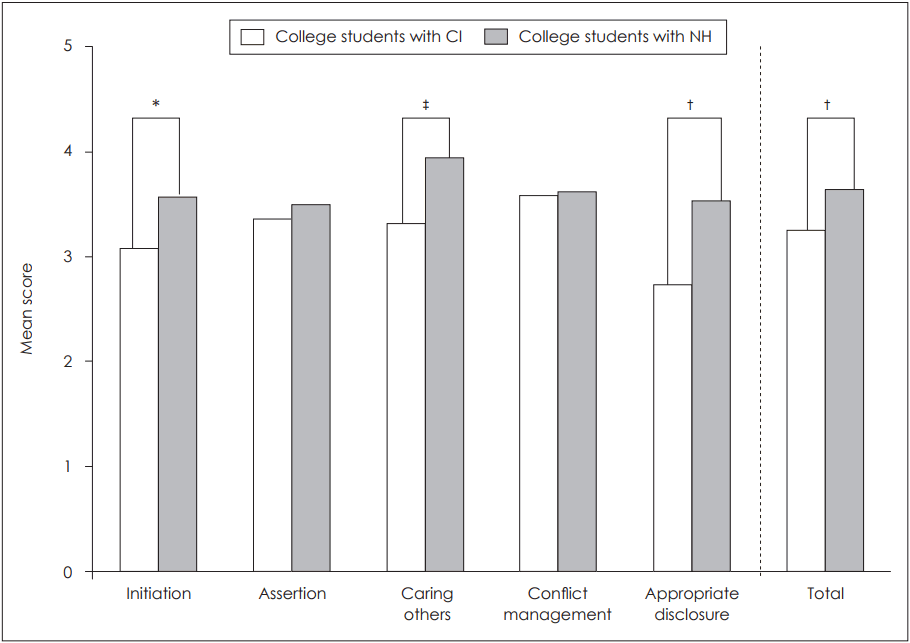
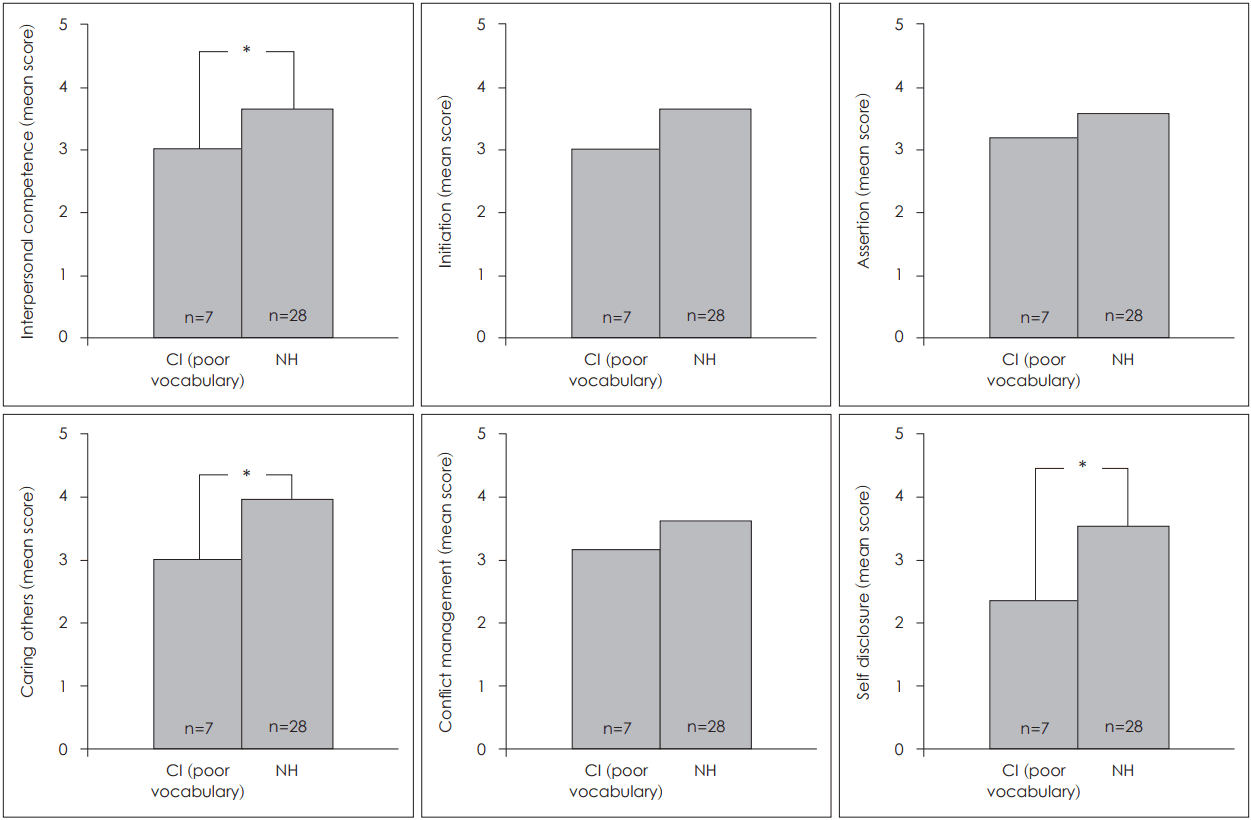
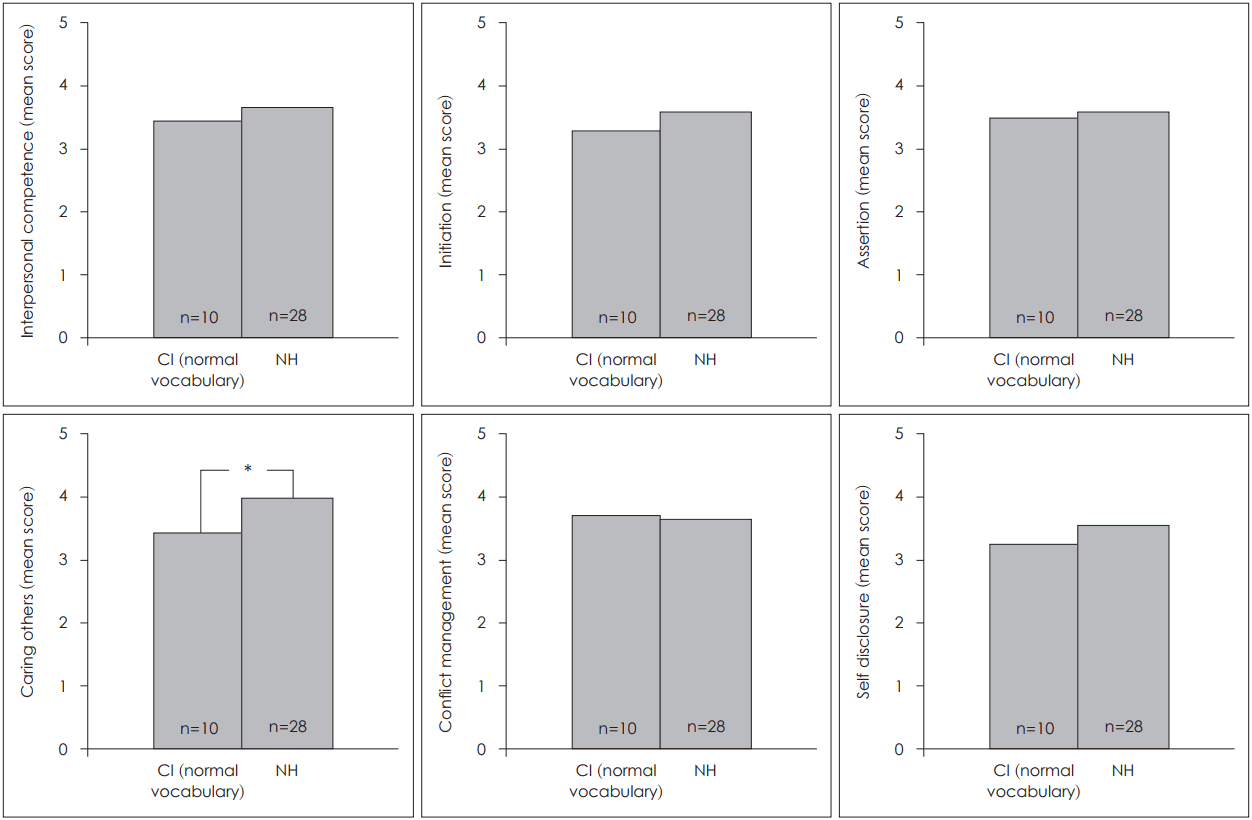
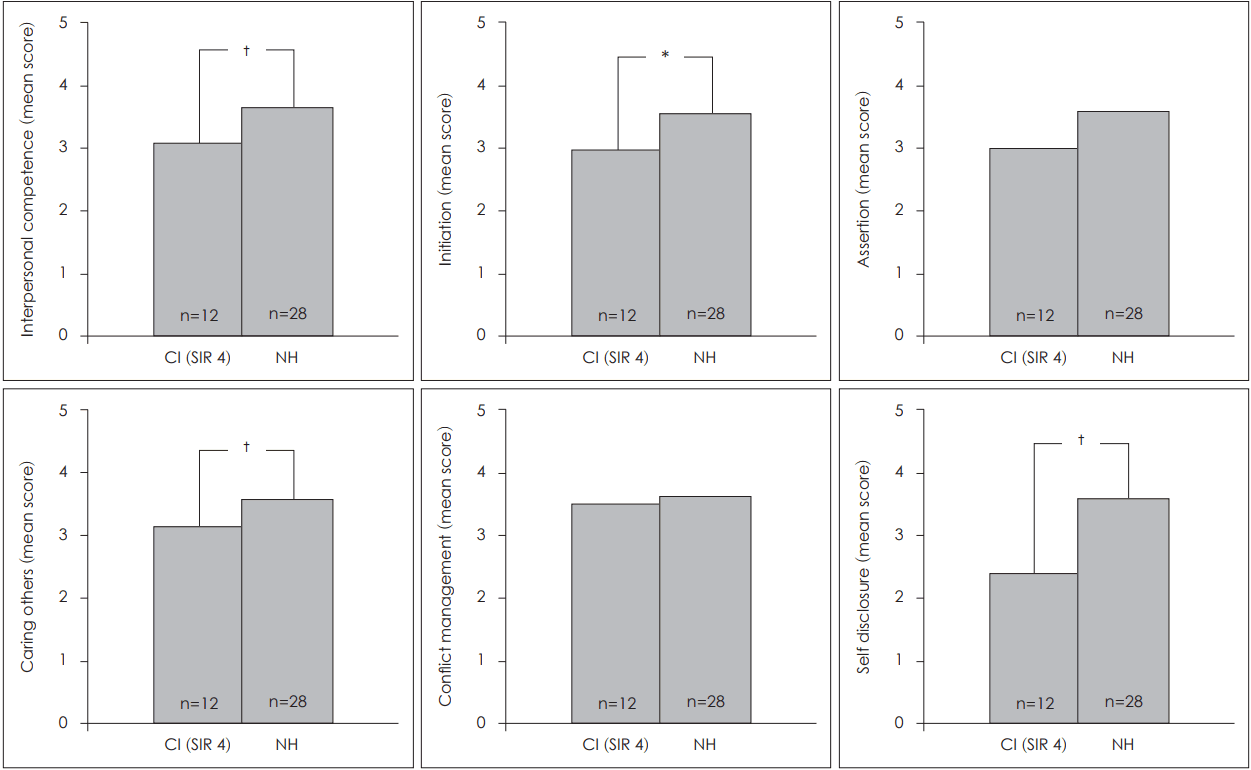
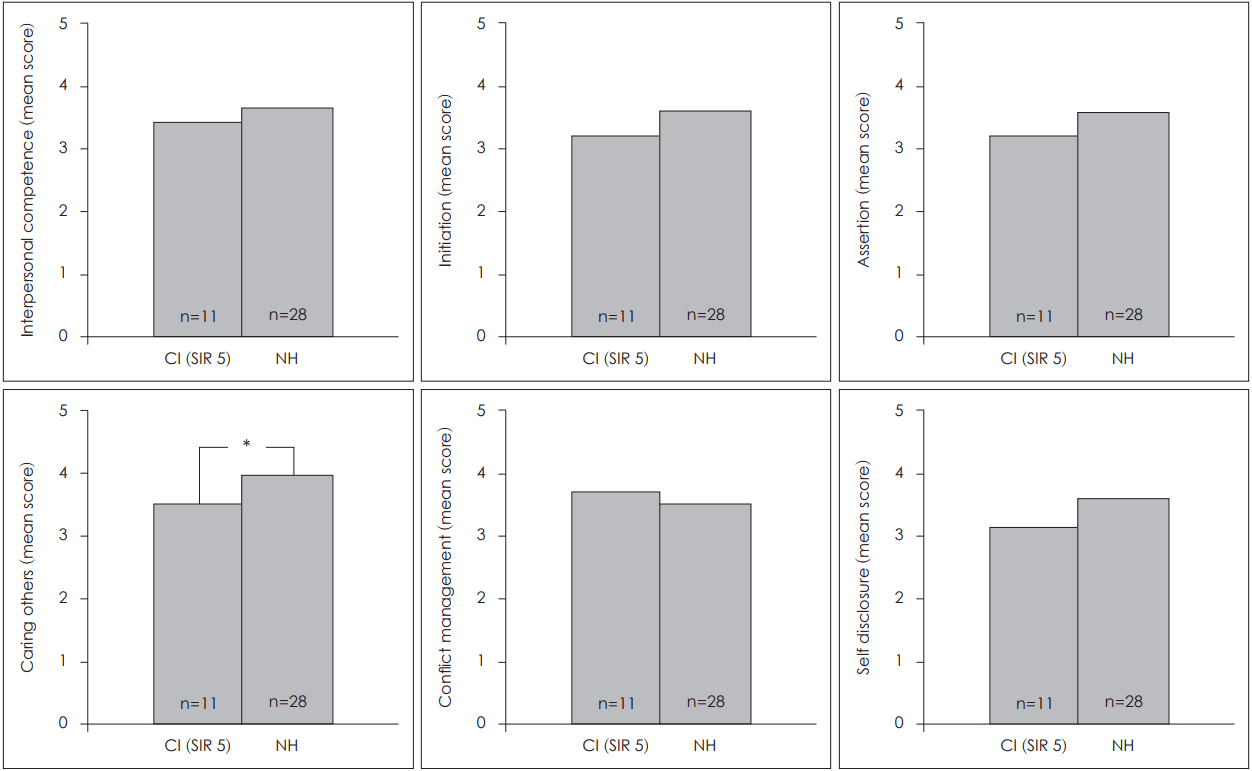
 XML Download
XML Download